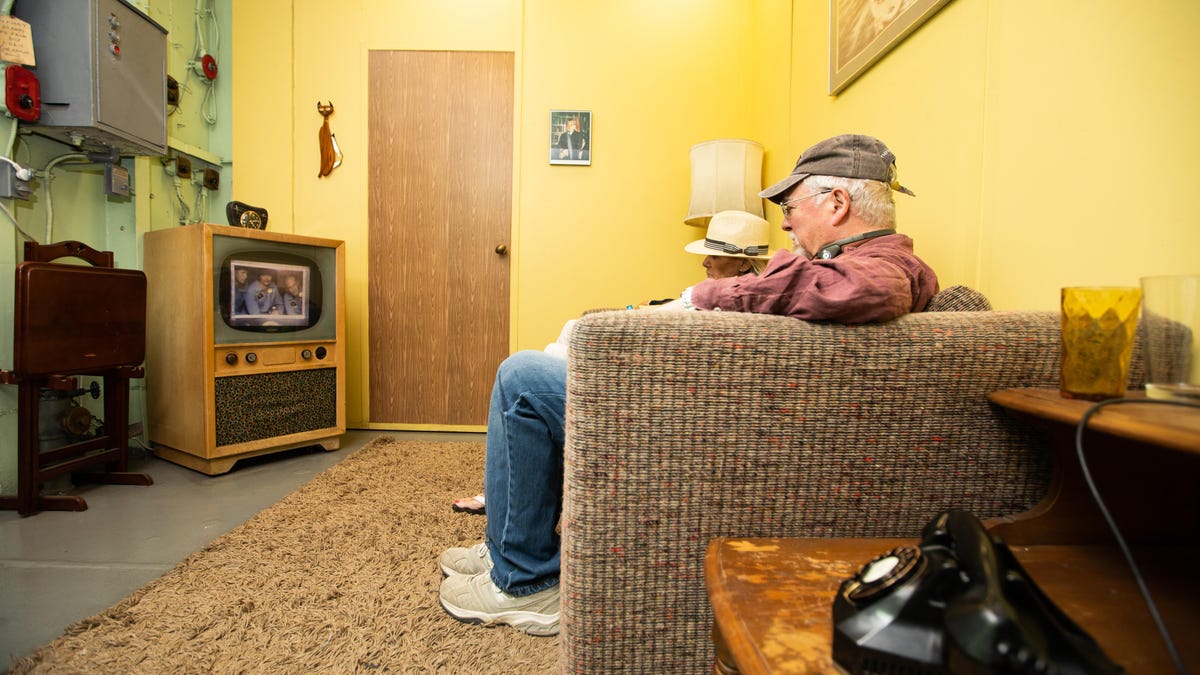Recovering Apollo 11 -- and the quarantine with spray cheese
The USS Hornet, now a museum docked in California, recovered the three Apollo 11 astronauts and their Command Module Columbia after the first moon landing mission.

It was July 20, 1969, when from their living rooms around the country, millions of Americans tuned in to their TVs to watch Neil Armstrong and fellow astronaut Buzz Aldrin make cosmic history as the first humans ever to set foot somewhere other than Earth.
Here, in a replica 1960s-era living room aboard the USS Hornet, the footage is recounted as it might have been experienced then. This was one of the first worldwide media events -- the astronauts cast as heroes as every moment was broadcast live around the world.
The USS Hornet, which is now a museum docked in Alameda, California, recovered the three Apollo 11 astronauts -- Neil A. Armstrong, Michael Collins, and Edwin "Buzz" Aldrin -- and their Command Module Columbia from the first moon landing mission after splashdown about 900 miles southwest of Hawaii in the Pacific Ocean on July 24, 1969.
To commemorate its role, the Hornet on Saturday, July 20, 2019, will host a Splashdown Celebration that will celebrate the five Apollo missions from 1968-1969, leading up to and including Apollo 11.
This CM-011 Apollo 1 Block Command Module is the first iteration of what would become the final capsule design. This particular Command Module was used for unmanned missions, demonstrating structural integrity and compatibility with the launch vehicle and confirming launch loads.
The USS Hornet served as the recovery vessel for CM-011 for its AS-202 mission. The Command Module was recovered off of Wake Island on August 25, 1966, 1 hour and 33 minutes after liftoff.
A closer look at some of the 1960s-era electronics on the CM-011 Apollo 1 Block Command Module through a cut away panel.
A Sikorsky SH-3H Sea King aboard the USS Hornet is painted to reflect the squadron from the movie Apollo 13, No. 66. Operated from the USS Hornet, No. 66 recovered five manned missions, including recovery of the crews of Apollo 11 and 12 from the decks of the USS Hornet in 1969.
That original Sikorsky is now at the bottom of the ocean, having crashed off the coast of San Diego in 1975.
After recovering Armstrong, Collins, and Aldrin from the floating capsule, the Sikorsky landed on the flight deck of the USS Hornet and was moved below.
Below deck, footprints are painted to mark the steps the three Apollo 11 astronauts -- Neil Armstrong, Michael Collins and buzz Aldrin -- took below deck on the USS Hornet from the Sikorsky helicopter as they entered the quarantine facility -- a modified Airstream trailer.
This Airstream is official known as one of four NASA Mobile Quarantine Facility (MQF). The airtight mobile trailers were built for the Apollo 11, 12, 13, and 14 missions to quarantine returning astronauts for 21 days. Scientists were worried the space travelers might return with infections that could harm Earth's inhabitants.
Once inside the trailer, the astronauts and an accompanying flight surgeon were flown to the Lunar Receiving Laboratory (LRL) in Houston, Texas.
Although the inside of the Mobile Quarantine Facility wasn't large or very spacious, it did have bunks, a microwave and medical diagnostic equipment and far more space that the cramped Command Module the astronauts were coming from.
A transfer lock was made for items to be passed in or out of the trailer. Waste was stored inside in special containers, also held for the full 21-day quarantine period.
The daily menu for NASA's Mobile Quarantine Facility included crepes, bacon, pancakes and syrup, Roast Beef sandwiches, vanilla ice cream and strip steak.
Though the astronauts said they generally liked the food in the Mobile Quarantine Facility, they did have a few additional requests. Items requested included spray cheese, raisins, candy, cookies and soda.
A view of the seating area inside the Mobile Quarantine Facility (MQF) through the window.
Apollo 11's recovery was punctuated by the presence of US President Richard Nixon aboard the USS Hornet. The president chatted briefly with Armstrong, Aldrin and Collins through the window of the Mobile Quarantine Facility, remarking "the world has never been closer together before."
The headline of The Sacramento Bee newspaper on July 25, 1969 reads "Astronauts, In Good Shape, Start 21 Days Of Isolation."
A Hawaiian US Customs Declaration the Apollo 11 astronauts filled out upon their splashdown identifies their cargo as "Moon rock and Moon dust samples." The Apollo 11 crew brought back 22 kilograms of lunar material, including rocks, core samples and regolith.
Apollo 11 inspired the world, put ideas in motion in the minds of students, writers, scientists and artists. In the years following, the spotlight dimmed for manned moon missions, with the last footsteps on the moon happening just three years later in 1972. Today, it inspires more questions: where do we go next?

